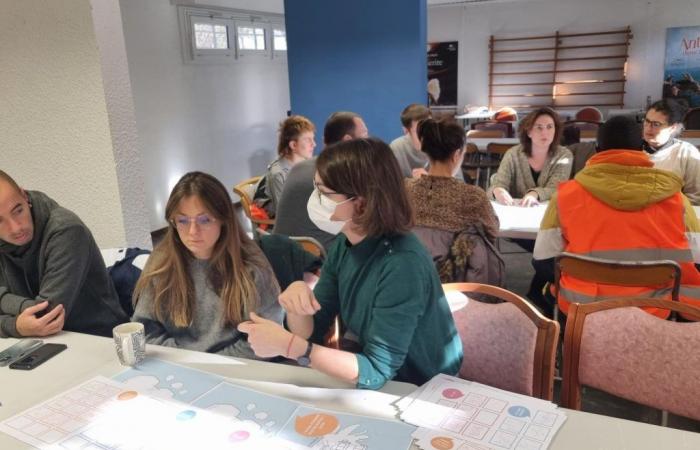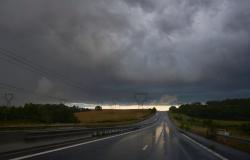Thursday evening, 6 p.m., in the middle of June. Alexandre Dorval is sitting on the Place du Jumelage, between a playground and a bench where watchful mothers have taken their places. Around, young people whirl around on scooters and call out to the teenager. At 17, the high school student has already given himself a mission: ” Take care of (at) generation “, in the Perrier district, in Annemasse (Haute-Savoie).
Several evenings a week, he invites dozens of young people to meet at the foot of the towers, on the « pump track » from the corner, a small tarmac circuit, with bumps and turns. “They are generally between 14 and 18 years old and they don’t know what to do: rather than turning to activities that could be harmful, we suggest they let off steam by skateboarding or cycling,” he summarizes.
A year ago, the young man and some of his friends were preparing to launch the Jeunes de coeur association, to organize intergenerational outings, when the first riots broke out following the death of Nahel, in Nanterre. Annemasse then experienced several nights of unrest and damage caused by a group of around fifty young people, most of them minors.
“Since Covid, there was this feeling of abandonment and we knew that things were going to end… It was a moment that made us want to take things in hand, a trigger. » Behind him, the Nelson-Mandela space, former youth center, still bears the marks of this period: openings covered with plywood and a condemned entrance. The place, symbol of the district, was set on fire on the night of June 30 to July 1, 2023.
The shock, the incomprehension, then the explanation
In this town of 40,000 inhabitants, as in many medium-sized towns, this violence initially came as a shock. Here, several disadvantaged and priority neighbourhoods, such as Le Perrier or Romagny, have long been plagued by drug dealing points, “but the atmosphere is good there, we cannot consider them as hot or dangerous places…”, estimates a resident, mother of three young children.
“I just need to teach a few life lessons from time to time, but never anything too serious! “, confirms a trader who has been established for forty-five years at the foot of a building. On the municipal side, “we knew about occasional problems, but we didn’t sense any particular crisis.” Residents and elected officials, however, eventually face the facts: this violence, although amplified by the power of social networks, expresses the anger of young people lacking consideration.
In this border area with Switzerland, where inequalities are particularly felt – Annemasse is the fourth most unequal city in the country (Observatory of Inequalities, 2020) –, precariousness has gradually increased, notes Monia, mother of four children and president of a parents’ association: “More and more people are running around having a barely mediocre quality of life and this is causing parenting problems. »
Many see it above all as the result of a story that has become ” a classic ” in the neighborhoods: the decline of popular education. Like Perrier. Seven years ago, the MJC, which had participated in the emancipation of an entire generation of big brothers and big sisters, closed, following a financial management problem. It has since been replaced by the city’s “Youth” service, with methods considered more strict and less appropriate.
“We missed something with the teenagers”
At the head of Annemasse for more than fifteen years, Christian Dupessey recounts his own sudden realization: “In a few days, we realized that we had missed something with the teenagers. » During the first post-riot municipal council, on July 5, 2023, the mayor (PS) announced “neighborhood meetings”. The idea? Go out and meet residents, especially young people, to ask them directly: ” What do you need ? »
Started in the fall, the process is supported by Nalisse, a consultancy firm specializing in citizen participation, and relies on the entire associative fabric. Result: more than 1,200 contributions and respondents aged 17 on average.
Since then, 114 actions have been announced, ranging from the development of public spaces to the prevention of delinquency. Around ten positions have been created and six agents have just been recruited. Youth leaders or specialist educators, they will arrive on the ground from the start of summer.
“We are waiting for them… But already, I have the impression that we have finally been heard: our children have ambition, they just need to be supervised by competent adults, who can give them confidence in them and give them good advice”, explains Samira, co-founder of Mamans de cœur, an association fighting against isolation.
Long-awaited initiatives
Many associative actors say they took advantage of this period to discuss “fundamental questions”, and sometimes even start to work together, like the partnership signed between a parents’ association and the city’s MJC. This “general momentum” naturally unlocked long-awaited initiatives.
“Since November, we have set up a big futsal session, every Friday evening, for young adults, explains Nadia Djebiha, specialist prevention educator for the Passages association, in the Romagny district. It’s an essential social space for this generation that feels marginalized, and it’s really very successful!”
The various players in youth activities have opted for a few adjustments: the return of activities at the foot of the buildings and work in pairs between city agents and professionals from the MJC, better known in the neighborhoods. Because familiar faces are more likely to hit their target.
Among the various meetings or outings offered by “Young at Heart”, some regularly attract minors who participated in the riots. “What pleases me, I think, is that these are proposals made by them and for them… I even have the impression that some have changed their state of mind! “, rejoices Alexandre, who saw the number of active members of his association increase from 10 to 75 in just one year.
However, not everyone is hopeful. Starting with some social workers who, after years of protest, say they have given up. “We haven’t come to talk to us yet, and we can’t say that there have been huge changes,” also let go of two teenagers, crossed at the bottom of a building, who nevertheless admit to having heard of “new things” for them. Also, it will still take time to reach “balance and appeasement”, summarizes Xavier Chantoiseau, director of the MJC. But he is convinced: “The tension has subsided. »
—–
A heavy toll
The information mission created in the Senate to analyze the riots delivered its conclusions on April 9, 2024. The elected officials described a “unprecedented surge of violence”which resulted in 1,000 injuries, as well as 1 billion euros in damage.
The typical rioter would be “a man aged 23 on average, single, without children, often staying with his parents, having a secondary school diploma, maximum baccalaureate, mostly working. More precisely, 91% of the authors are men, 71% are of French nationality,” describe the senators.
The violence, initially confined to the surroundings of Nanterre (Hauts-de-Seine), have “shifted towards an insurrectional phase throughout the territory” until July 1, before falling again immediately.






